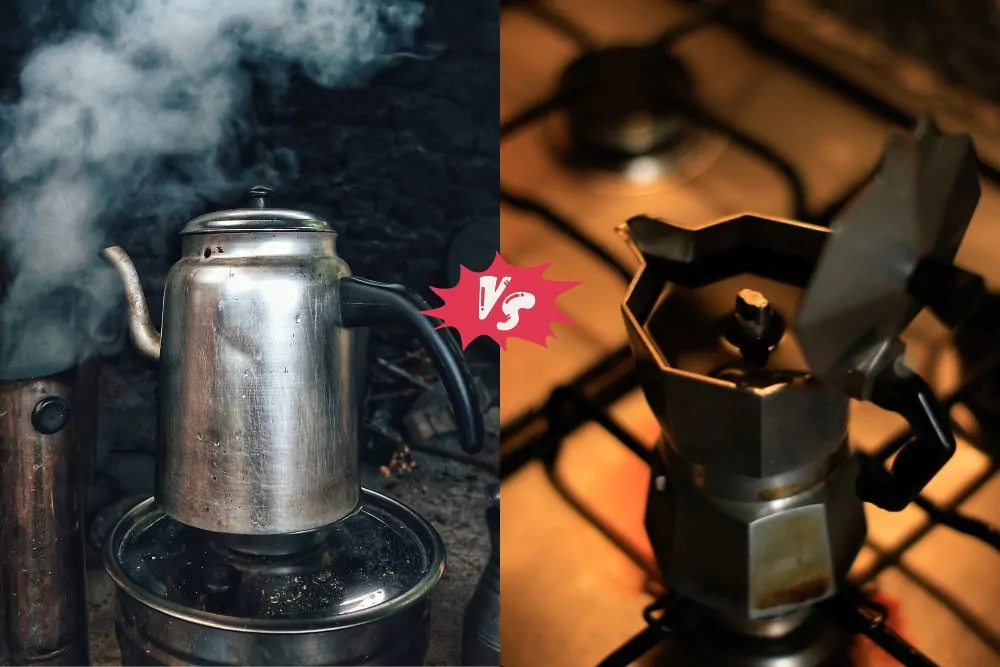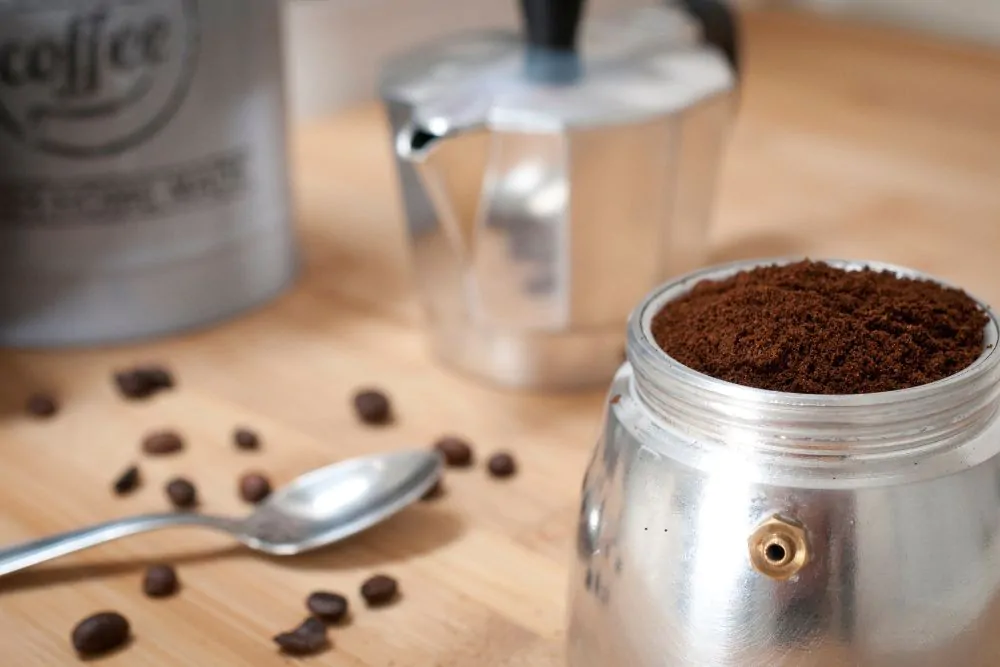Explore the unique brewing mechanisms of Coffee percolator vs. Moka pot. Discover which coffee maker suits your taste for the perfect home-brewed experience.

A percolator continuously cycles boiling water through coffee grounds using gravity until reaching the desired strength. A Moka Pot uses pressure like an espresso machine to push hot water through coffee grounds, resulting in a strong and richly flavored brew.
The Moka pot delivers an espresso-like creaminess but comes with a bit of a learning curve. Providing you use the best coffee for a percolator, it will brew a tasty beverage and is almost as easy to use as a drip coffee machine.
|
Feature |
Moka Pot |
Percolator |
|
Brewing Mechanism |
Uses pressure to force hot water through the coffee grounds. |
Continuously cycles boiling water through the coffee grounds using gravity. |
|
Flavor |
Produces a strong, rich brew, somewhat similar to espresso. |
A robust flavor, but risk of over-extraction can lead to bitterness. |
|
Ease of Use |
enerally easy to use, but needs monitoring to prevent overheating. |
Can be left unattended; automatic versions can control the brewing process. |
|
Brewing Time |
Takes about 5-10 minutes depending on heat source and size of pot. |
Typically 7-10 minutes, but can vary based on model and volume. |
|
Grind Size |
Requires a medium to fine grind. |
Requires a coarse grind. |
|
Coffee Strength |
Makes a concentrated, strong coffee. |
Strength varies depending on brewing time; can be strong but potentially bitter if brewed too long. |
|
Portability |
Compact and portable; great for travel. |
Size and design vary; smaller models are portable. |
A Brief History of Moka Pots and Percolators
Parisian tinsmith Joseph-Henry-Marie Laurens discovered the principle behind the coffee percolator in 1819, that is, the rising of boiling water through a tube to form a continuous heating cycle. The first US patent for a coffee percolator was issued to James Nason from Franklin, Massachusetts, who patented the first percolator design in 1865, and Illinois farmer named Hanson Goodrich patented the modern U.S. stove-top percolator as it is known today.
Alfonso Bialetti invented the Moka pot in 1933. He named it after the Yemeni city of Mocha, and the concept quickly became popular in Europe and the United States during and after World War II. Read our Moka pot history to learn more.
Brewing Methods

The Moka pot utilizes a bottom-to-top brewing method, leveraging steam and pressure to create an intense, concentrated brew reminiscent of espresso, albeit served in smaller doses and without an espresso’s high-pressure steam or crema layer.
Contrastingly, the percolator employs a drip-coffee mechanism within a single chamber, where hot water repeatedly cycles through medium to medium-coarse coffee grounds housed in a basket near the lid. This top-to-bottom process can yield a robust brew, yet the flavor and strength can vary greatly depending on the brewing time.
The distinctive coffee each brewer creates – the strong, espresso-like coffee from a Moka pot and the robust, potentially varied strength coffee from a percolator – ultimately shapes your preference and experience.
Flavor
Percolators don’t produce coffee with the same bold taste as Moka pots but make far larger quantities. They make an average-strength coffee without that robust, highly concentrated taste found in Moka pots.
It’s easy to over-extract coffee in a percolator (leading to a bitter taste) and expect less control over your brew. However, for the regular coffee drinker, it’s hardly a problem given how quick, affordable, and easy-to-use coffee percolators are, which is why it remains one of the most popular brewing methods used to date.
For me, the Moka pot wins hands-down. I’m a big fan of strong coffee. A Moka pot brew is similar to one from an espresso machine. Their strong, bold taste, which is rarely over-extracted and bitter, makes my coffee more enjoyable. Furthermore, Moka pots are more consistent too. Sometimes, you never know what you’re going to get with a percolator.
Price
Moka pots are relatively cheap compared to other coffee brewers, depending on the quality you’re aiming for. You can also buy different sizes of Moka pots, and there is a diversity of percolators. It’s a good idea to set a budget.

Price differences also apply to the type of coffee. The extra-fine coffee grind used in Moka pots typically costs about $0.30-1.74 per ounce, while the standard medium-size grind you’ll likely be using for your percolator costs between $0.30 and $1.00 per ounce. Percolators produce larger quantities of coffee, which may make them better value for money for you.
Ease of Use
When shopping, a coffee percolator will make life a lot easier because medium-sized coffee grinds are standard, and you’ll never struggle to find them in stores as you may with the extra-fine grind size needed for Moka pots.
Both brewers are relatively similar in ease of use and require coffee, water, and a heat source. They’re both effortless to clean, but for deep cleans, the pipes in percolators and the coffee basket in the Moka pot can make life difficult for you. But, for everyday use, both score high regarding convenience.
Again, for more people, this is where percolators win. It makes far greater quantities of coffee than Moka pots, and, to many people, this makes them more convenient to use. Percolators are probably the best choice for you unless you prefer quality over quantity.
Other Coffee Brewing Methods
Several other methods to brew coffee may be a better solution if you don’t like what percolators and Moka pots offer. Here’s a quick look at a few of them:
A French press is another incredibly popular brewer that’s incredibly useful and similar to a percolator in that it soaks coffee grinds in hot water but uses a push-down filter to separate your brew from the extracted coffee grinds. It’s a cheap and easy method, but the taste isn’t anything exceptional.
Espresso machines, on the other hand, are costly and tricky to use. Using high pressure to extract a concentrated brew similar to that of a Moka pot (but better), espresso machines aren’t for beginners but still produce the best taste, in my opinion.
An Aeropress is a much cheaper, simpler way to make coffee, making delicious, consistent brews in about 30 seconds. It’s a cylindrical chamber and a plunger with an airtight seal, similar to a syringe. Hot water and ground coffee are forced through a filter by pressing the plunger through the chamber.
Then you get drip coffee machines requiring you to add ground coffee to the filter paper, press a button, and wait. They can vary in price but cost far less than espresso machines, producing a smooth, consistent taste. But they take their time, so don’t expect to use your drip coffee machine on the go.
Finally, we get the pour-over coffee machine, which is similar to a drip machine in that it holds coffee in filter paper, and water is poured over it to brew. However, it’s far less automated and gives you more control over the brew, with all kinds of unique kettles, spouts, and other gadgets that allow you to cultivate a cup of perfectly extracted coffee that gives you the optimal taste. They are also relatively inexpensive.
Which Is Better Coffee Percolator Vs. Moka Pot?

A Moka Pot is better than a percolator if you prefer more control over the strength and taste profile of your coffee. It’ll help any coffee lover brew a balanced beverage at home. However, a percolator is more suitable if you value affordability, convenience, and ease of use. Just don’t expect it to taste as nice.
I may be getting a smaller cup, but I’m getting just as much caffeine and don’t need to take as many bathroom breaks later in the day. This is a matter of personal preference, and the right cup of coffee for you is, after all, a very personal thing. If you don’t care much for your coffee tastes like, want to spend as little money as possible, and are deadset on drinking 10 cups daily, you may prefer a percolator.
But you can’t put a price on waking up every morning with a perfectly brewed cup of coffee that didn’t cost an arm and a leg.
